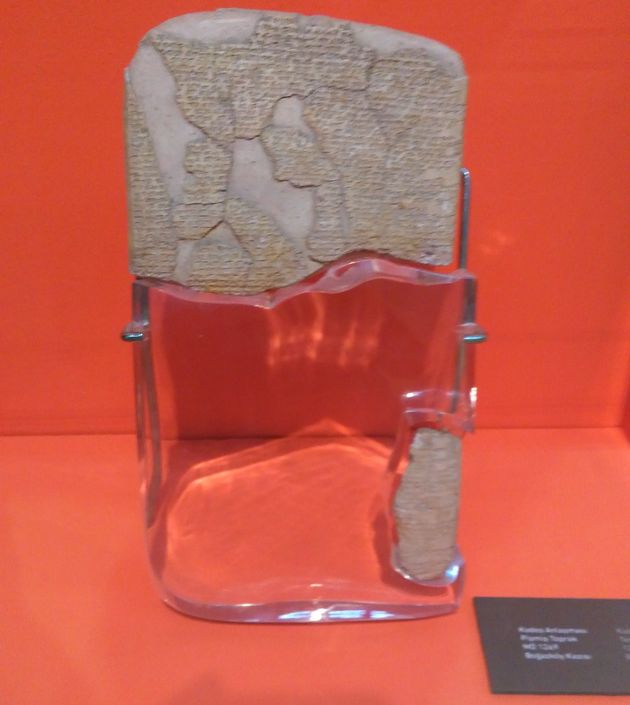As two superpowers left the Levant, a power vacuum was created. Canaan was left alone, ripe for conquest.
 Treaty of Kadesh. Istanbul Archaeological Museum. / Marc Madrigal
Treaty of Kadesh. Istanbul Archaeological Museum. / Marc Madrigal
The year was 1274 BCE. Depending on your Exodus chronology, the Hebrews were just about leaving Egypt in order to settle into the Promised Land (late date) or were in the middle of their conquest of Canaan (early date).
But what was happening in the rest of the world? Sometimes we delve into the Scriptural narrative so deeply that we miss the greater picture of what was going on in the world.
The same is true for us today! We get so focused on the particulars of our own story, that we miss the greater picture of what God is doing in our world; of how He is directing history to accomplish His purposes!
In the Mid 13th century BCE two of the world’s superpowers were the Hittites in the North and the Egyptians in the South. Both wanted to take control of the region that we know today as Palestine and Syria.
The reason was simple, expansion and control of important trading routes. Ramesses II represented the Egyptians, while the Hittites were led by Mutawalli II. A fierce battle ensued in Kadesh, a region which borders modern Lebanon and Syria.
This was the biggest battle the world had seen to date. Approximately 50,000 men and 6,000 chariots clashed against each other.
The battle was a tug of war. Both forces tried to overpower their opponent but ultimately failed, and the battle ended in a stalemate.
In 1259, Ramesses II and Hattusili III signed a peace treaty which resulted in the retreat of the Egyptian and Hittite forces from the Levant. The treaty was written in the Akkadian language, the lingua franca of the time.
The Hittite version of the treaty, which is being displayed in the Istanbul Archaeological Museum, was discovered by Hugo Winckler in 1906. The treaty was found in the archive of the ancient Hittite capital of Hattusha.
The Kadesh peace treaty is known as the oldest peace treaty in history. Because of its significance, a replica of the treaty is also displayed in the United Nations headquarters in New York.
Here is a translation of some portions of this treaty:
“It is concluded that Ramesses , the Great King, the king (of the land of Egypt) with Hattusili, the Great King, the king of the land of Hatti, his brother, for the land of Egypt and the land of Hatti, in order to establish a good peace and a good fraternity forever among them.
(…)
Thus speaks Ramesses…to Hattusili, son of Mursili…Look, I have established a good fraternity and a good peace now forever among us, in order to establish this way forever a good peace and a good fraternity between the land of Egypt and the land of Hatti.
(…)”
The treaty concludes with a series of provisions for political exiles. Hittite prisoners who escape to Egypt are to be returned to the Hittites without punishment. Likewise, Egyptian prisoners that flee to Hittite lands are to be returned to Egypt without punishment.
As these two superpowers left the Levant, a power vacuum was created. Canaan was left alone, ripe for conquest. From the 14th to the 13th century BCE, while Egypt was having this period of conflict with the Hittites, we have numerous mentions of the Hapiru in ancient documents.
The word Hapiru is etymologically unrelated to the word Hebrew. It was used for displaced, semi-nomadic wondering folk. People who had left the cities in search of a better life. Canaanite city-states were practically oligarchies where the lower classes were oppressed.
Given this situation, many chose to leave and try their luck elsewhere. However, this word could still be a word that was used for the Hebrew people.
As we learn in the Amarna letters of the 14th century numerous Canaanite city-states began to be attacked simultaneously by an organized group of Hapiru who began taking them down one by one.
Even though several Canaanite vassals wrote letters to their Egyptian overlord and pharaoh, they never obtained a response.
Egypt was going through a turbulent political period with both Akhenaten’s monotheistic revolution in the 14th century and later Ramesses’ conflicts with the Hittite empire in the 13th century.
The Treaty of Kadesh is for me a symbol of God’s sovereignty. God was masterfully orchestrating global political events to accomplish His purposes. He was clearing away two world superpowers to facilitate the Hebrews to conquer Canaan.
But more importantly, this treaty is a symbol of God’s grace. For all this was occurring at a time when the Hebrews fell into sin time and time again. God was being faithful to his covenant promise despite the shortcoming and sins of the people.
God was not acting in the way the people deserved, rather, he was being good to them despite their lack of faith. In short, seeing the big picture makes all the difference.
Marc Madrigal is a Board member in the Istanbul Protestant Church Foundation in Turkey.
BIBLIOGRAPHY
Clyde E. Fant; Mitchell G. Reddish. Lost Treasures of the Bible: Understanding the Bible through Archaeological Artifacts in World Museums (Kindle Location 934-942). Kindle Edition.
Pasinli, Alpay. Istanbul Archaeological Museums. A Turizm Yayinlari. Istanbul, 2012.
The peace treaty between Ramses II and Hattusili III.

Las opiniones vertidas por nuestros colaboradores se realizan a nivel personal, pudiendo coincidir o no con la postura de la dirección de Protestante Digital.
Si quieres comentar o